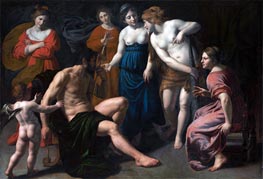
Alessandro Turchi Giclée Fine Art Prints
1578-1649
Italian Baroque Painter
Alessandro Turchi, also known as L’Orbetto, is a painter whose work threads delicacy and drama into a refined, almost lyrical Baroque style. Born in 1578 in Verona, Turchi’s early years were shaped by the workshop of Felice Riccio, known as il Brusasorci. But like so many artists of his generation, he was destined to move beyond the regional. By the time his teacher died in 1605, Turchi had already begun to develop his own independent practice. He quickly stepped into prominence in Verona, completing significant commissions, like the organ shutters for the Accademia Filarmonica, and proving himself a master of complex compositions.
There is a softness to Turchi’s work that sets him apart from the more dramatic Caravaggisti. His paintings possess a quieter kind of intensity - one where light glows, rather than slices. Take, for example, his "Diana and Actaeon." The figures are rendered with a grace that tempers the violence of the myth, a moment of transformation held in tender suspension. This ability to balance the theatrical with the intimate defined Turchi’s approach, particularly in Rome, where he arrived by 1616. Here, in a city brimming with artistic competition, he found his footing, contributing frescoes to the Quirinal Palace and becoming known for his smaller cabinet paintings, often executed on black marble with an extraordinary sense of finesse.
In Rome, Turchi worked for some of the most powerful patrons of the day, including Cardinal Scipione Borghese. Yet his ties to Verona remained strong. Throughout his career, he moved between the two cities, completing altarpieces and private commissions alike, always with a focus on light - soft, enveloping, and radiant. His "Flight into Egypt" for the church of San Romualdo in Rome captures this luminosity perfectly, as does his "Resurrection of Christ" for the cathedral of Sant'Andrea in Bordeaux. Both works show how he handled religious themes with a balance of grandeur and emotional depth, always rooted in the human experience.
Turchi’s stature grew in both the Veronese and Roman circles, and in 1637 he became Principe of the Accademia di San Luca, Rome’s most prestigious art academy. A year later, he joined the Pontifical Academy of Fine Arts and Letters of the Virtuosi al Pantheon, further cementing his influence. Yet, despite his accolades and success, Turchi’s work remains most captivating in its quiet, intimate moments - where the drama of Baroque is softened into something more personal, almost contemplative. His "David with the Head of Goliath," for instance, presents not only the heroism of the biblical story but also a reflection on victory’s cost. Alessandro Turchi died in Rome in 1649, but his paintings endure, shimmering with a light that transcends the time in which they were made.
There is a softness to Turchi’s work that sets him apart from the more dramatic Caravaggisti. His paintings possess a quieter kind of intensity - one where light glows, rather than slices. Take, for example, his "Diana and Actaeon." The figures are rendered with a grace that tempers the violence of the myth, a moment of transformation held in tender suspension. This ability to balance the theatrical with the intimate defined Turchi’s approach, particularly in Rome, where he arrived by 1616. Here, in a city brimming with artistic competition, he found his footing, contributing frescoes to the Quirinal Palace and becoming known for his smaller cabinet paintings, often executed on black marble with an extraordinary sense of finesse.
In Rome, Turchi worked for some of the most powerful patrons of the day, including Cardinal Scipione Borghese. Yet his ties to Verona remained strong. Throughout his career, he moved between the two cities, completing altarpieces and private commissions alike, always with a focus on light - soft, enveloping, and radiant. His "Flight into Egypt" for the church of San Romualdo in Rome captures this luminosity perfectly, as does his "Resurrection of Christ" for the cathedral of Sant'Andrea in Bordeaux. Both works show how he handled religious themes with a balance of grandeur and emotional depth, always rooted in the human experience.
Turchi’s stature grew in both the Veronese and Roman circles, and in 1637 he became Principe of the Accademia di San Luca, Rome’s most prestigious art academy. A year later, he joined the Pontifical Academy of Fine Arts and Letters of the Virtuosi al Pantheon, further cementing his influence. Yet, despite his accolades and success, Turchi’s work remains most captivating in its quiet, intimate moments - where the drama of Baroque is softened into something more personal, almost contemplative. His "David with the Head of Goliath," for instance, presents not only the heroism of the biblical story but also a reflection on victory’s cost. Alessandro Turchi died in Rome in 1649, but his paintings endure, shimmering with a light that transcends the time in which they were made.
1 Alessandro Turchi Artworks

Giclée Canvas Print
$56.38
$56.38
SKU: 16798-TUR
Alessandro Turchi
Original Size:166.5 x 237 cm
Alte Pinakothek, Munich, Germany
Alessandro Turchi
Original Size:166.5 x 237 cm
Alte Pinakothek, Munich, Germany